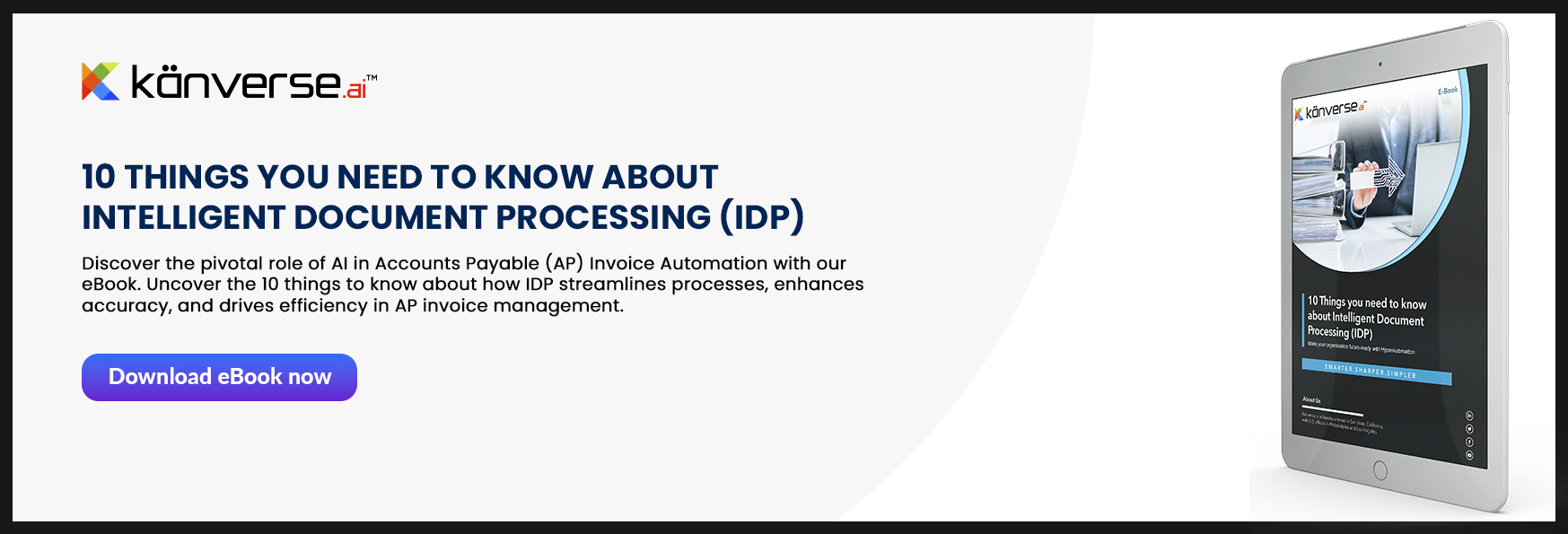
From Back-Office to Frontline: How AI Agents
Will Revolutionize AP by Interacting with
Vendors and Stakeholders
In most enterprises, Accounts Payable (AP) remains a complex, manual, and reactive function. Even with advances in OCR, Intelligent Document Processing (IDP), and workflow automation, the real bottleneck lies not in extracting data, but in interacting with vendors, handling exceptions, coordinating stakeholders, and driving timely resolutions.
What if an intelligent AI agent could take over not just invoice capture, but the remaining 60% of work, the vendor emails, the clarifications, the approvals, the escalations, the follow-ups, and the scheduling?
At Kanverse.ai, we believe this is not a distant future, it’s the logical next step in AP transformation. AI Agents are poised to act as intermediaries between enterprises, vendors, and internal teams, improving accuracy, timeliness, deliverability, and vendor relationships at scale.
The Current Limits of AP Automation
Despite the proliferation of automation tools, most AP teams still face similar challenges:
- Vendor interactions remain manual: Even if invoice capture is automated, mismatches, missing information, or clarifications require email threads, phone calls, or ticket escalations.
- Exceptions dominate workflows: A large percentage of invoices fall out of “happy paths” due to PO mismatches, tax issues, or approval delays.
- Stakeholder coordination is fragmented: Procurement, legal, finance approvers, and vendors often communicate in silos.
- Lack of feedback loops: Automation systems rarely learn from vendor corrections or recurring errors.
- Vendor experience is reactive: Suppliers must chase status updates, which strains relationships and delays payments.
This is why, in practice, many AP automations only reduce manual work by 30–40%, leaving the remainder to be resolved manually by overworked teams. This is precisely where agentic AI comes in.
The Market Is Signaling a Shift
Multiple studies and industry analyses highlight both the potential and gaps in current AP automation:
- A global Accounts Payable Automation Trends 2024 study found 60% of invoices are still keyed manually and teams spend over 10 hours a week on invoice processing.
- Tipalti reports that AI-based AP automation can reduce processing costs by 81%, speed up processing by 73%, and cut human errors by up to 40%.
- Forrester forecasts rapid expansion of AI in AP use cases—from document intelligence to fraud detection and compliance.
- Gartner recently issued a strong caution: the supply of agentic AI is outpacing enterprise demand, and a market correction is looming. Over 40% of agentic AI projects may be scrapped by 2027 due to unclear business value and “agent washing” (mislabeling traditional AI as agentic).
* Sources: Tipalti, Forrester, Gartner via Reuters
The signal is clear: basic automation is not enough, and ungrounded hype will be punished. The winners will be those who use agentic AI to deliver measurable ROI in real business workflows like AP.
Why AI Agents Are Uniquely Suited for AP
AI agents go beyond static RPA bots or narrow AI models. They bring autonomy, reasoning, and interaction into financial workflows:
- Autonomy & orchestration – Agents can plan, monitor, escalate, and resolve multi-step workflows end-to-end.
- Natural interaction – They communicate with vendors via email, portals, or APIs, asking for missing info, clarifying discrepancies, or sharing status updates.
- Context awareness – Agents understand vendor history, contracts, policies, and approval thresholds to tailor actions.
- Closed-loop learning – They learn from vendor responses and human overrides, improving over time.
- Cross-system integration – Agents connect ERP, procurement, payment, vendor portals, and internal comms seamlessly.
These capabilities make them ideal for the messy 60% of AP work that traditional automation leaves behind.
Table Of Contents
- From Back-Office to Frontline: How AI Agents Will Revolutionize AP by Interacting with Vendors and Stakeholders
- The Current Limits of AP Automation
- The Market Is Signaling a Shift
- Why AI Agents Are Uniquely Suited for AP
- What 60% of AP Tasks Could Be Handled by Agents
- A Realistic Scenario: Agent Handling a Vendor Invoice
- Kanverse.ai’s Differentiated Approach
- Conclusion
Related Blogs
What 60% of AP Tasks Could Be Handled by Agents
| AP Task | AI Agent Role | Impact |
| Invoice ingestion & extraction | Auto-ingest from email/portals; IDP extraction | Near-touchless capture, 99%+ accuracy |
| Vendor data amplification | Outreach for missing data, vendor master hygiene | Better data, fewer delays |
| 3-way matching | Validate invoice vs PO, receipt, contract | Reduced exceptions, faster approvals |
| Exception handling | Query vendors automatically for clarifications | Less manual back-and-forth |
| Approval routing | Route invoices intelligently, send reminders | Higher throughput |
| Vendor status updates | Automated responses via portal/email | Stronger vendor experience |
| Payment scheduling | Optimize cash flow, discounts, timelines | Better working capital management |
| Fraud/anomaly detection | Monitor duplicate invoices, amount deviations | Increased trust & control |
A Realistic Scenario: Agent Handling a Vendor Invoice
Here’s a simplified illustration of how an AI Agent operates in an AP workflow:
- Invoice arrives: A vendor sends a PDF invoice via email. Kanverse’s IDP ingests and extracts all key data (vendor, line items, amounts, PO references, etc.).
- Agent validates & matches: The agent cross-checks the invoice against the PO and contract. It notices that line 2 amount is $120,000, while the PO specifies $100,000.
- Agent crafts vendor query: The agent sends: “We see that line 2 amount ($120,000) exceeds the PO line amount of $100,000. Please confirm if this includes extra shipping or share a revised invoice.” Attachments: PO snapshot, contract snippet, prior invoice references.
- Vendor responds: The vendor replies: “Yes, extra shipping was added; new invoice attached.” The agent re-ingests, validates, and reconciles the invoice automatically.
- Routing & approval: Because the extra cost exceeds a 10% threshold, the agent routes the invoice to procurement for approval, with all supporting context.
- Payment scheduling: Upon approval, the agent optimizes payment timing (cash flow, discounts) and triggers the payment via banking API.
- Vendor notification: The agent emails: “Your invoice is scheduled for payment on [Date]. Payment Reference: [Ref]. Please let us know if you need further assistance.”
- Reconciliation & dashboards: The agent matches the payment in ERP, updates KPIs, and flags anomalies for human review if needed.
This scenario demonstrates how agents don’t just “read invoices”, they close the loop with vendors, internal teams, and systems autonomously.
Learn more about How Agentic AI is transforming Intelligent Document Processing (IDP)
Kanverse.ai’s Differentiated Approach
Kanverse.ai is uniquely positioned to deliver this vision:
- Deep document intelligence foundation — Our IDP engine delivers high-accuracy data extraction and validation, forming a reliable base for agents.
- Vendor portal integration — Agents act not just through email but within a vendor-facing portal, enabling real-time status checks and two-way communication.
- Composable agent architecture — Agents can be introduced gradually, over existing workflows, no “rip and replace.”
- Domain expertise in AP — We build AP-specific logic, policies, and exception frameworks, not generic chatbots.
Conclusion
Gartner’s warning about agentic AI oversupply is timely: hype alone won’t survive. The future belongs to solutions that combine agentic intelligence with real domain depth, governance, and ROI.
In AP, the opportunity is enormous. By empowering AI agents to handle vendor communications, exception resolution, approvals, and scheduling, organizations can automate more than 60% of AP work, strengthen vendor relationships, and give finance teams the bandwidth to focus on strategy, not fire fighting.
At Kanverse.ai, we’re not just imagining this future, we’re building it with our customers today.


